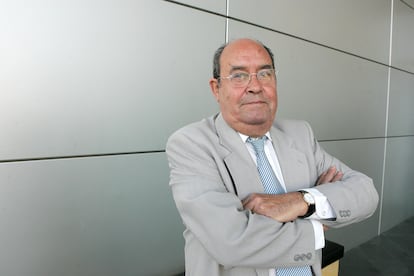The profound knowledge we have today of the biology of living beings has its origins in a series of discoveries made between the 1960s and 1970s. The discovery of the structure of DNA provided a mechanism for the inheritance of traits from parents to children and paved the way for understanding the action of genes. The cloning of toads and frogs has shown that genetic information, written in DNA, is not lost in the transformation of the first cell into the whole that is a living thing, and along the way we have learned the basic rules of how genes contribute to that transformation. Most of these studies were conducted in academic references such as Oxford, Cambridge, Boston and New York, but the last one had its epicenter in Madrid in the 1970s and was a product of the work of Antonio García-Bellido (1936-2025), with the humble vinegar fly.
Like much of what concerns science in Spain, the name is not well known in our parts. The only way a scientist comes to prominence is when he receives an award, gets involved in a scandal, or dies. Recognized throughout the world, apart from several awards, including the Prince of Asturias, and some specific references, Antonio García-Bellido has remained anonymous to the Spanish public. His death brought him to the news and served to remind us that our country is the cradle and land of influential scientists and that – as happened a few years ago with Francisco Mojica, the discoverer of CRISPR – they are not prophets in their land.
García-Bellido, Antonio to his colleagues and students, did not go unnoticed. Those of us who knew him remember his roars with which he expressed his thoughts, his doubts, his questions. With him there were no light conversations, those that fill silences. A man with little vain, intense, passionate about science, incisive in his intuitions about living beings, always absorbed in his thoughts. It was precisely his obsession with big questions that on more than one occasion prevented him from institutionally developing the potential that emanated from his science. He thought that institutions could be built based on scientific coups when, especially in Spain, something more was needed. Even so, he involuntarily contributed to the development of science in Spain by training several generations of students, encouraging colleagues, such as Juan Modolell, to new adventures and inspiring others who followed him from abroad.
Born in Madrid into a family with a great humanistic tradition, García-Bellido developed an early interest in biology. His guide was his father’s library, where he read voraciously and little by little found his destiny: to unravel the logic in the construction of living beings. It is likely that this self-taught exercise was the origin of the inquisition to which he subjected students who wanted to work with him. As part of the process there was an interview where the first question was always: “What did you read?” For him, science was part of a vast cultural whole that had its roots in individual curiosity.
It was the 1950s and biology had already been working on understanding the mechanisms of heredity for half a century. The problem of the development of a living being starting from a fertilized egg has been set aside, without clear contributions that could open the way to understanding. In Spain, the Civil War had buried the shoots generated by the spirit of the Free Educational Institution and what remained of science had been reduced to a veneration, more religious than content, of Santiago Ramón y Cajal. García-Bellido’s teacher was his father’s library, where a plan was drawn up: to understand physiology, cell-building capabilities and genetics; in this order.
He begins a thesis somewhat casually with Eugenio Ortiz on a mutation in Drosophilathe vinegar fly. While working on his doctorate, his restlessness leads him to collect tools. Visit Cambridge and Zurich to learn about physiology and what the role of cells can be in building an organism. But he senses that the secret lies in genetics. As he once said, genetics “is Ariadne’s thread that helps us in the labyrinth of our biological questions,” alluding to the ball used by the hero Theseus to escape the Minotaur’s labyrinth in Greek mythology. With this idea, in 1968, after completing his doctorate, he arrived at Caltech, California, where he would have what I call the revelation of his life.
Before leaving for the United States he must complete an experiment, part of a study on the role of cells in building the fly’s wing. The details aren’t important, but the fact of the matter is that you’ve marked the cells to follow on the wing as the fly grows. The experiment requires an X-ray machine that the CSIC, where he works, doesn’t have, so he improvises. He irradiates himself with a machine that he finds in the clinic of a dentist friend. Then he lets the flies grow and, once the experiment is over, he collects them in well-marked jars and goes to the United States with the flies in his suitcase. Once there, he begins to examine the results of the experiment and begins to understand. What he observes is that, depending on the age of marking, the cells occupy more or less territory and that they do not do so randomly, but rather following spatial rules of colonization. At Caltech, working with Ed Lewis – a future Nobel Prize winner for his work on the role of genes in development – you will begin to understand that genes allow cells to read those rules and that the genes that do this work are special. He calls them “selectors” because they select what cells do.

Upon his return to Madrid, with the help of his collaborator and wife María Paz Capdevila, he set up a laboratory at the CSIC in Velázquez Street. At that time he is lucky that his first three students are brilliant. During the 1970s Morata, Ripoll and Santamaria are surnames that join García-Bellido in a series of articles that illuminate the relationship between genes, cells and the construction of living beings and attract attention abroad. These works invent the genetic approach to the problem of development. In 1975 his group moved to the Center of Molecular Biology of the Autonomous University of Madrid, of which García-Bellido was a founding member and where his laboratory became a sort of mecca for the discipline he founded.
Among microscopes and flies, in a cloud of smoke from the Duchy that visitors who came from all over the world remember in that period, hypotheses were formulated, experiments were planned, results were analyzed and discussed, science was exported. The ideas and above all the methods that were forged in those years in Madrid under the guidance of García-Bellido created very solid foundations that today continue to bear fruit in the understanding of the development of living beings. Students and collaborators of the 1980s and 1990s will remember the endless laboratory meetings of that time, in which García-Bellido acted as the pontiff of the new developmental biology, proposing new experiments, questioning the results and asking for clarity, sometimes without providing it on his part, but always provoking, stimulating, asking to go further in understanding the facts. This was Antonio, a self-taught man with a passion for science reminiscent of Ortega y Gasset’s vision of science in Spain: “brazen, audacious, it will acquire certainty by leaps and bounds (…). Barbarian, mystical and errant science.”
Much has been written these days about his contribution to biology. There was talk of invisible lines drawn by genes, which, in a sense, are what draws attention to what he and his disciples found in the fly. But the reality is simpler and more understandable than that real, but somewhat mystical, vision of his work. His legacy is more general and transcendent. What we are left with is the idea that the domain of action of genes is the cell and that it is through the cell that they build structure. Like any good scientist, he also leaves us with a question: how conversations between cells control space and shape. García-Bellido was also a pioneer in suggesting that, in development, genes organize themselves into sets – networks, as we would say today – to sculpt the tissues of an organism, in his case the fly. Betraying the humanistic environment in which he had grown up, he presented the idea in linguistic terms, speaking of genetic sentences, insisting that genetics is the grammar and not the phonetics of cells.
The measure of a scientist is not only given by his work, but above all by his imprint. There is no doubt that García-Bellido leaves a great mark in both cases. Several generations of scientists trained by him are dispersed throughout the world developing ideas and critical judgment learned in Madrid. And one interesting thing: everyone, when they talk about him, remembers him with an affection that sometimes does not correspond to the legend of a grumpy and prickly character.
García-Bellido’s farewell was joined in the last month by those of James Watson and John Gurdon, two other pioneers of modern biology. Where Watson will always be linked to DNA and Gurdon to cloning, García-Bellido will remain linked to that Ariadne’s thread which he saw as a vehicle, the vehicle, for understanding the problems of biology. I imagine him – as he once said, paraphrasing Goethe’s last words – saying: always genetics, more genetics.
Alfonso Martinez Arias He is an ICREA professor at Pompeu Fabra University.



